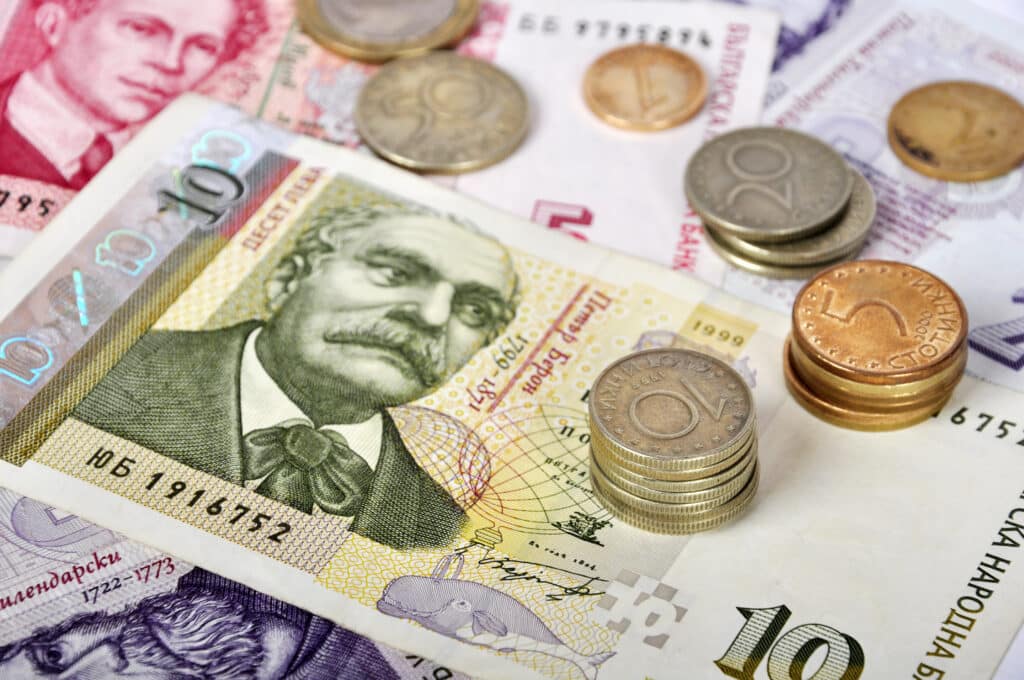The Republic of Bulgaria is one of the Balkan nations in eastern Europe. With vast landscapes and incredible architecture, Bulgaria has a lot to offer those who may visit. In Bulgaria, the currency is called the “Bulgarian lev,” or “leva” if you are speaking about it in the plural. The lev is issued by the Bulgarian National Bank, the country’s central bank. “BGN” is its currency code and “лв” is the currency symbol. One lev can be subdivided into 100 stotinki. Bulgarian leva are available in coins and banknotes.
Bulgarian coins come in the following denominations:
- 1, 2, 5, 10, 20, and 50 stotinki
- 1 and 2 lev
Bulgarian banknotes come in the following denominations:
- 1, 2, 5, 10, 20, 50, and 100 lev

Exchange Rates
To see the current Bulgarian lev-to-dollar exchange rate, check out today’s rate with Remitly.
5 Interesting Facts About the Bulgarian Lev
Learning about world currencies can provide insight into each country’s culture. Here are some fun and fascinating facts about the currency used in Bulgaria.
1. The word “lev” points to a symbol of Bulgaria.
“Lev” can be translated to “lion” in an older form of the Bulgarian language. Lions in Bulgaria are symbolic of strength and courage. The lion became the official symbol in 1878 after Bulgaria regained independence from the Ottoman Empire. Today you can see lion statues all around Bulgaria.
Here are some famous sites where you can find lion statues:
- Lion’s Bridge in Sofia
- Monument to the Unknown Soldier in Sofia
- Palace of Justice in Sofia
- Tsarevets Fortress in Veliko Tarnovo
- Sofia Court House in Sofia
2. The country’s money features notable Bulgarians.
Famous Bulgarians are featured on lev banknotes and coins.
- 1 lev coin and banknote: Saint John of Rila, the patron saint of Bulgaria.
- 2 leva coin and banknote: Saint Paisius of Hilendar, a clergyman, author, and National Revival figure. He is most notable for writing the second modern Bulgarian history, Istoriya Slavyanobolgarskaya, in 1765.
- 5 leva banknote: Ivan Milev, a painter and scenographer in the early 20th century whose style exemplified Bulgarian modernism.
- 10 leva banknote: Dr. Petar Beron, a scientist and educator who was known for creating the first book printed in modern Bulgarian, The Fish Primer, in 1924.
- 20 leva banknote: Stefan Stambolov, prime minister of Bulgaria from 1887 to 1894.
- 50 leva banknote: Pencho Slaveykov, a writer whose most famous work is “Kurvava Pesen,” an epic poem that he never finished about the Bulgarian fight for independence.
- 100 leva banknote: Aleko Konstantinov, a writer in the late 19th century who created a famous character in Bulgarian literature named Bay Ganyo.

3. Stotinki coins depict a Bulgarian World Heritage Site.
All stotinki feature the same imagery, regardless of how much they are worth. One side displays the denomination — 1, 2, 5, 10, 20, and 50 stotinki. The other side shows the Madara Rider, a cliff carving in Madara, Bulgaria.
The Madara Rider is a UNESCO World Heritage Site. The carving depicts a knight on a horse defeating a lion. Madara was a sacred place for the First Bulgarian Empire before its people were converted to Christianity. The carving was made during the eigth century.
4. Bulgarian currency has anti-counterfeit features.
Counterfeit money is a very rare issue in Bulgaria. Modern banknotes have multiple security features that prevent counterfeiting. The 100-lev banknote, for example, has a stripe that changes color when the bill is tilted, security fibers embedded in the paper, and a three-dimensional portrait as a watermark that can be seen from both sides of the bill.
5. The lev will be replaced by the euro.
Bulgaria has been a member of the European Union since 2007. While it did not initially adopt the euro as its currency, it has since committed to make the transition. Euros are expected to become the official currency of Bulgaria starting January 1, 2024.
A Brief History of the Bulgarian Lev
The history of the lev is very interesting, and even though Bulgaria has endured much political change and turbulence, the lev has remained steadfast. The lev was first created when Bulgaria gained independence from the Ottoman Empire in the late 19th century. It had been under the empire’s control for centuries.
The lev remained the currency throughout Bulgaria even through two wars (World War I and II) and while it was under the control of the Soviet Union. Although the banknotes have always been called the lev, new versions were introduced multiple times. The version of the lev that is used today was introduced in 1995.

Sending Money to Bulgaria
You can send money to Bulgaria with Remitly. New customers may be eligible for a special offer on their first transfer.
Further Reading
If you are looking to learn more about foreign currency, transferring money internationally, or exchange rates, you might be interested in the articles below.